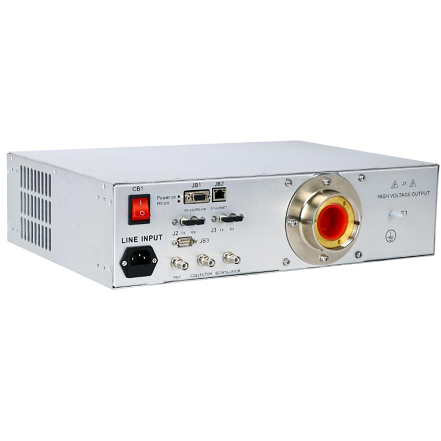A Field Emission Scanning Electron Microscope (FESEM) is an electron optical instrument that uses high-energy electron beams to observe and analyze high-resolution images of a sample surface. It has the advantages of ultra-high resolution, continuous adjustable magnification and strong three-dimensional image, and is one of the most important analytical instruments in modern scientific research and plays an irreplaceable role in many research fields. In order to give full play to its functions, extend its service life, and avoid failures, it is necessary to do a good job in the maintenance of scanning electron microscopy in daily use, strengthen standardized management, and better serve for teaching and scientific research. Taking Zeiss Gemini 500 field emission scanning electron microscope as an example, this paper mainly introduces the experience of routine maintenance and management of scanning electron microscope, and provides reference and help for colleagues.
1. Routine maintenance
Scanning electron microscopy is an expensive, complex structure of large precision instrument, need multiple
systems to work together, once the failure, it is difficult to determine the specific problem. Therefore, in addition
to strictly standardized operation, the daily maintenance of scanning electron microscopy is particularly important.
1.1 Maintenance of Environmental Conditions
The external environmental conditions of SEM generally involve factors such as temperature, humidity, exhaust gas,
vibration/noise, magnetic field and ground, which will interfere with the normal trajectory of the electron beam and
make the image drift, jitter, distortion or distortion. In order to ensure the normal operation of scanning electron
microscopy and energy spectrum, the indoor temperature is generally controlled between 18~25 ° C, the relative
humidity is controlled between 40% and 70%, and additional facilities such as air conditioning and dehumidifier are commonly used to maintain the relative stability of indoor temperature and humidity to avoid damage to the
electronic components inside the electron microscope. In order to ensure air circulation in the electron microscope
room, an external exhaust fan is usually installed to ventilate the room. Because the field emission scanning
electron microscope has strict requirements on the interference of ambient vibration, environmental noise and
external stray magnetic field, the impact on high-power image acquisition should be reduced by installing a shock
absorber, placing peripheral auxiliary facilities in the compartment of the electron microscope room, not talking
loudly during testing, and installing a demagnetization device. In addition, the ground wire of SEM must be a
special independent ground wire, good grounding can effectively improve the signal-to-noise ratio and stability
of electron microscope images and energy spectrum. In short, the environmental conditions in the electron
microscope room should be strictly controlled in the daily operation process to ensure that the scanning electron
microscope can operate normally, safely and reliably. Using the Gemini 500 SEM as an example, the environmental
conditions are as follows: the temperature is maintained at 20 to 24 ° C, the relative humidity is less than 65%, the
AC magnetic field strength is less than 1 mG(10-7 T), the ambient noise is less than 65 dB, and the ground
resistance is less than 0.1 Ω.
1.2 Electronic optical system maintenance
In electron optics system, the condition of filament and diaphragm directly affects the image quality of SEM. Taking
the Gemini 500 scanning electron microscope as an example, its electronic optical system maintenance is as follows:
Filament maintenance:
(1) Minimize the number of switching electron beam high pressure and vacuum extraction, maintain the high
vacuum of the tube, slow down the oxidation of the filament, and extend the service life and efficiency.
(2) The use of low voltage and small aperture diaphragm, reduce the filament current, can effectively slow the loss
of the filament.
(3) Do not close the filament in daily use, affecting the life of the filament.
(4) The sample to be observed must be dry and free of moisture and other volatile substances to prevent the
filament from fusing or sudden extinction.
Objective diaphragm maintenance:
(1) Use a longer working distance and a suitable diaphragm aperture to keep the diaphragm clean.
(2) Minimize the pollution caused by the vacuum system itself and extend the service life of the diaphragm, such
as the mechanical pump should regularly change the oil, and the cooling circulating water machine should have
sufficient cooling capacity.
(3) The magnetic sample should be pre-demagnetized, because it will affect the trajectory of the electron beam,
and it is easy to adsorb to the interior of the vacuum chamber and pollute the diaphragm.
(4) Samples containing water or volatile solvents such as organisms must be dried to prevent damage to parts such
as the diaphragm caused by gas volatilization.
(5) The surface of non-conductive or poorly conductive samples is sprayed with metal film to improve the electrical
and thermal conductivity of the sample, reduce the thermal damage and thermal decomposition of the electron
beam to the sample, and avoid affecting the performance of the electron microscope.
(6) Samples such as fractures or blocks can be washed with alcohol or acetone before testing to effectively remove
stains and ensure that the sample is clean and free of contaminants.
(7) The powder sample must be firmly glued and purged with the ear ball or compressed gas to avoid
contaminating the electron microscope diaphragm and other components.
(8) The field emission diaphragm is generally cleaned once before replacing the new diaphragm.
Check the diaphragm in the center: determine whether the diaphragm is in the center, in the process of high-power
repeated focusing, a feature point of the image is not in the original position of the "fuzzy - clear - fuzzy" process,
but the position of this feature point changes, the image is seriously offset, that is, the diaphragm is not good. The
adjustment method is as follows: press the Wobble button on the Control Panel of the operation panel, set Scan
Speed, and adjust the value of Wobble Amplitude, so that the degree of image jitter can help judge the direction
of image jitter. Then adjust the Aperture center knobs Aperture X and Aperture Y, so that the image no longer runs,
in place of the "beat", that is, concentric magnification and contraction, adjust the image and press the Wobble
button to exit. Notice Before adjusting Wobble, ensure that Scan Rotate is zero for Wobble adjustment.
Check the astigmatism: determine whether the image has astigmatism, that is, repeatedly focusing at high power
is not clear, and the image is stretched in the direction perpendicular to each other, resulting in blurred or deformed images. The adjustment method is: adjust the Focus button on the Control Panel of the operation panel until the image is not stretched, and then adjust the two anastigmator X and Astigmator Y respectively until the image is clear, that is, the edge of the feature point is clear.
1.3 Vacuum system maintenance
In order to ensure the normal operation of the electron optical system, the vacuum degree in the tube and the
vacuum degree in the sample chamber are required by the scanning electron microscope. Insufficient vacuum will
cause the sample
In addition to being polluted, it will also cause problems such as reduced filament life and high voltage electrode
discharge. Different types of scanning electron microscopy have different requirements on the vacuum degree. For
the Gemini 500 high-precision and high-vacuum field emission scanning electron microscopy, the vacuum system
is mainly composed of the front oil-free mechanical pump, oil-free magnetic suspension turbomolecular pump,
and ion pump three vacuum pumps to maintain the ultra-high vacuum of the electronic optical system. Sample
chamber Vacuum System Vacuum is generally required to be above 5.0×10-6 mbar, by mechanical pump and
molecular pump to achieve, electron Gun Vacuum is generally not less than 1.0×10-9 mbar, by ion pump to
achieve. The mechanical pump first pumps the vacuum of the sample chamber, after reaching the required vacuum
degree, the molecular pump starts to continue to pump the vacuum of the sample chamber, when the exhaust
speed of the molecular pump reaches 50% of the rated speed, the Penning gauge starts to work; When the vacuum
degree of the sample chamber reaches more than 2×10-5 mbar, the ion pump starts to vacuum the tube.
Note in routine maintenance:
(1) When replacing the sample, be sure to close the isolation valve CIV to separate the tube from the sample
chamber to keep the vacuum in the tube from being destroyed.
(2) Keep the tube in a certain vacuum state for a long time, even if the scanning electron microscope is not
working, it should be turned on 1 to 2 times a week to prevent the internal rust of the tube.
(3) Check whether there is abnormal sound when the vacuum pump works, clean the cooling fan and filter of the
vacuum pump, and regularly replace the sealing kit of the vacuum pump.
(4) Bake the ion pump regularly.
1.4 Maintenance of accessory facilities
Check the status of the cooling circulating water regularly, the general water temperature is controlled at 18~20 ℃,
the water pressure is maintained at 2~3 bar, and the flow rate is 1.0~1.8 L/min. The water level of the water tank
should be close to the height of the water refill hole, if it is lower than the warning line, distilled water should be
added in time and bacteriostatic agents should be added to avoid the breeding of microorganisms or organic
impurities. If the water quality becomes cloudy, the water tank should be cleaned and the water in the tank and
pipelines should be replaced to prevent the cooling circulating water system from blocking or scaling and affecting
the work efficiency.
Regularly check the pressure of the air compressor to ensure that the outlet pressure is 5~6 bar. Drain the water in
the bottle in time, otherwise it will easily lead to the blockage of the outlet pipe, resulting in the failure of the air
compressor. In addition, pay attention to the daily starting frequency of the air compressor, and replace the intake
filter regularly.
Periodically check the valve and connection parts of the nitrogen cylinder to ensure that there is no leakage. The
switching air valve should be operated slowly, and must not be too urgent or forcibly unscrew, so that the outlet
pressure is maintained at 0.2~0.3 bar. When using, it is best not to use up all the gas in the nitrogen cylinder, and
be sure to retain a residual pressure of more than 0.05MPa. At the same time, the cylinder should be firmly secured
to avoid shaking or tipping over.
Regularly open the functional systems that are not commonly used in scanning electron microscopy, such as the
backscatter electronic imaging system and plasma cleaning system, each time not less than 1 h to prevent the
failure of electronic components due to aging or moisture.
2. Daily management
Strict and standardized management is the prerequisite to effectively avoid the occurrence of scanning electron
microscope faults, which can play a role in preventing the gradual development of micro-faults.
(1) The electron microscope room must be kept clean and tidy, the experimenters must change slippers or wear
shoe covers before entering, the operators need to wear lab clothes, and the use of registration shall be carried
out after the test.
(2) Other personnel without training or management consent to use the instrument shall not operate on the
machine without authorization.
(3) Check and record the parameters (vacuum parameters, current parameters) in the use of scanning electron
microscopy to ensure the traceability of faults and facilitate troubleshooting.
(4) If the electron microscope fails in operation, the operator should immediately stop using it, write the situation
in the journal, and report it to the manager.
(5) After the observation, be sure to change the reset parameters back to the original parameters, turn Off the high
voltage EHT Off, otherwise it will affect the life of the filament. In addition, after the completion of the test, it is
not necessary to turn off the hardware power supply of the electron microscope, just turn off the power supply of
the computer monitor. The test results are sent by email, and the use of USB flash drives and portable hard drives
is prohibited.
If the sample needs to be recovered, the sample must be vacuumed immediately after taking out the sample, so
that the sample chamber can return to the high vacuum state as soon as possible, which can not only reduce the
pollution of the sample chamber and the mirror tube, shorten the down
The vacuum time during the next sample change will not easily accumulate water vapor in the mechanical pump,
resulting in turbidity, poor quality or frequent maintenance of the pump oil.
3. Safety precautions
(1) When using scanning electron microscopy, be sure to ensure the continuity and stability of the power supply,
and pay attention to the safety of electricity use. When a major emergency fault occurs, such as a short circuit or
fire, cut off the power supply to the device and the UPS immediately.
(2) When moving, lifting or tilting the sample table, it must be carried out in TV mode to ensure that the sample
table will not collide with the objective lens and detector. Especially in the process of rising the sample table, it is
necessary to observe the height of the sample, requiring the working distance WD > 8 mm.
(3) During normal testing, be careful not to touch the joystick, so as not to change the height and inclination of the
sample and damage the objective lens and detector. When the electron microscope is not used during the process,
Joystick Disable can be checked in the Stage Navigation of the sample table to prevent the damage of the objective
lens and detector by accidentally touching the joystick.
(4) When opening and closing the hatch door, it must be gently pulled and pushed to avoid damage to the
detection by impact or vibration
A surname
(5) The air conditioner in the electron microscope room must be kept open and cannot be closed. Because the
compartment is equipped with cooling circulation water machine, air compressor, mechanical pump, UPS power
supply and other equipment, the heat dissipation is very large during work, especially in summer, the temperature
is too high, which is easy to cause the equipment load is too large and damaged.
(6) Do not install other software on the computer dedicated to the electron microscope to prevent the computer
system from crashing.
(7) Do not place sharp small objects (such as screws, screwdrivers, etc.) on the main table of the electron
microscope to prevent damage to the air cushion.
Step 4 Summarize
Scanning electron microscopy as a large precision instrument, in daily use, in order to ensure the safety and normal
operation of the equipment, careful maintenance and strict management is very important. Through maintenance,
it can eliminate the interference factors of scanning electron microscopy to the maximum extent, detect potential
problems early, solve and repair them in time, avoid the expansion of the situation and reduce losses; At the same
time, strengthen daily management and regular inspection, so that the scanning electron microscope is in the best
working condition, and provide guarantee for obtaining good image quality and analysis results.















